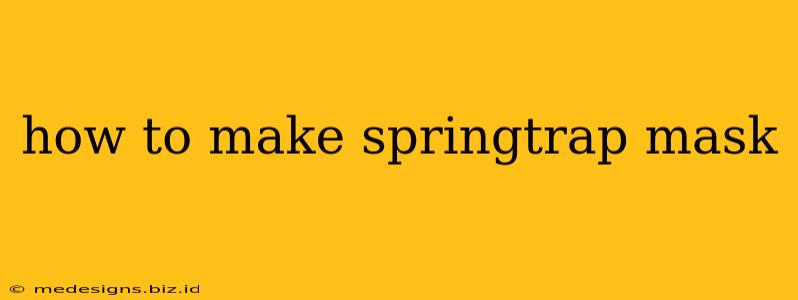Are you a Five Nights at Freddy's fan looking to create your own terrifyingly awesome Springtrap mask? This comprehensive guide will walk you through the process, from gathering materials to adding those final, chilling details. Get ready to become the nightmare fuel of your friends!
Materials You'll Need:
Before you begin, gather these essential materials:
- Foam: This forms the base of your mask. Craft foam works well, offering flexibility and ease of shaping. Consider thicker foam for a more robust mask.
- Paper Mache (Optional): For a stronger, more durable mask, you can add a layer of paper mache over the foam base.
- Hot Glue Gun & Glue Sticks: Crucial for assembling the various parts of your mask.
- X-Acto Knife or Craft Knife: Precise cutting is essential for intricate details. Be cautious and always use a cutting mat!
- Paint (Acrylic is Recommended): Choose colors that accurately reflect Springtrap’s metallic and decaying look. Think browns, greens, rusted oranges, and metallic greys.
- Paintbrushes: Various sizes for different details.
- Metallic Paint (Optional): To achieve that truly metallic Springtrap look, metallic paints are highly recommended.
- Wire Mesh (Optional): For adding realism to the mask's damaged areas.
- Sandpaper: For smoothing out rough edges and creating a more realistic texture.
- Clear Coat (Optional): Protects your paint job and adds durability.
- Reference Images: Numerous images of Springtrap are necessary for accurate sculpting and painting.
Step-by-Step Instructions:
1. Creating the Mask Base:
- Sketch Your Design: Start by sketching your Springtrap mask design onto paper. Refer to your images for accuracy.
- Cut the Foam: Carefully cut the foam according to your sketch. It's often easier to work in sections and assemble them later.
- Shape the Foam: Use your hands and the knife to gently shape the foam, creating the contours of Springtrap’s face. Take your time! Accuracy is key here.
- (Optional) Paper Mache Reinforcement: If desired, apply layers of paper mache over the foam to reinforce the structure and provide a smoother surface for painting. Allow each layer to fully dry before applying the next.
2. Adding Details:
- Wiring (Optional): If you're adding wire mesh to simulate damage, carefully cut and attach pieces using the hot glue gun.
- Sculpting: You may need to use additional foam or modeling clay to add finer details like Springtrap’s jaw and broken areas.
3. Painting Your Springtrap Mask:
- Base Coat: Apply a base coat of your chosen color. Allow it to dry completely before moving on.
- Layered Painting: Build up the colors gradually, layering different shades to achieve depth and realism. Focus on Springtrap’s characteristic metallic and decaying appearance.
- Details: Use smaller brushes to paint the intricate details, such as his eyes, mouth, and any exposed endoskeleton elements.
- Metallic Accents: Apply metallic paints to highlight certain areas, bringing out the metallic aspects of his design.
4. Final Touches and Sealing:
- Clean Up: Once the paint is dry, use sandpaper to gently smooth any rough edges or imperfections.
- Sealing (Optional): Apply a clear coat sealant to protect your paint job and add durability to your mask.
5. Putting it All Together:
- Assemble Sections: If you worked in sections, carefully hot glue them together.
- Add Straps: Attach straps (perhaps made from elastic or ribbon) to the back of the mask to secure it to your head.
Tips for Success:
- Take Your Time: Rushing the process will lead to mistakes. Patience is key!
- Reference Images: Keep your reference images close by throughout the process.
- Experiment with Techniques: Don’t be afraid to experiment with different techniques to achieve the desired look.
- Practice Makes Perfect: If this is your first time, consider practicing on smaller foam pieces before tackling the entire mask.
By following this guide, you can craft a truly frightening and impressive Springtrap mask. Happy crafting, and may your nightmares be filled with animatronic terror!
